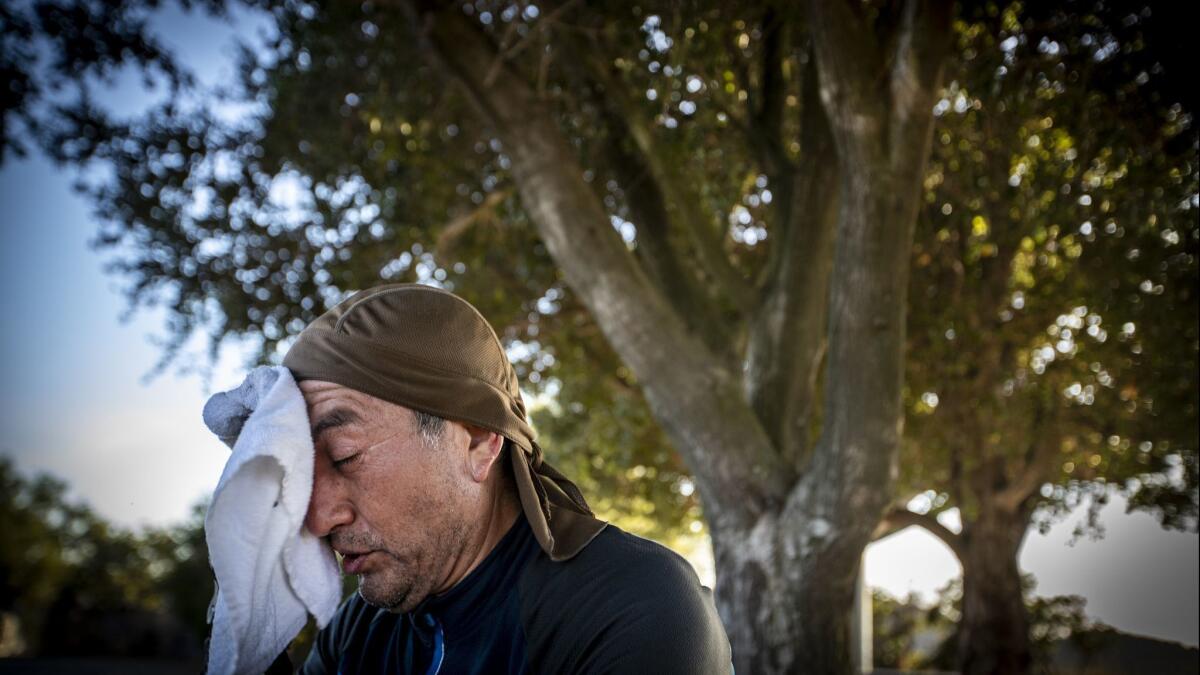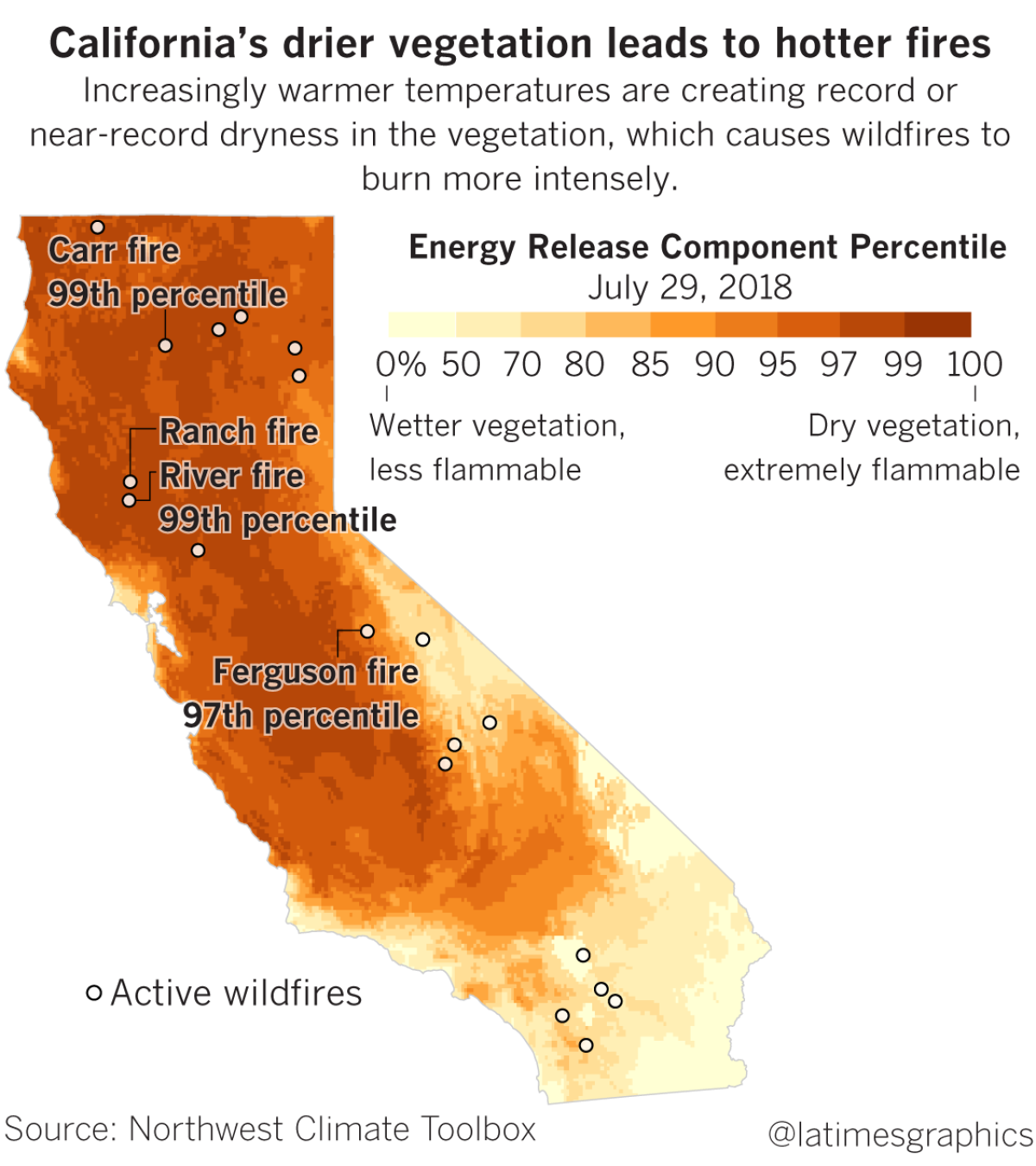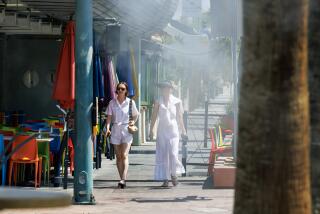California’s destructive summer brings blunt talk about climate change

Reporting from San Francisco — At Scripps Pier in San Diego, the surface water reached the highest temperature in 102 years of records, 78.8 degrees.
Palm Springs had its warmest July on record, with an average of 97.4 degrees. Death Valley experienced its hottest month on record, with the average temperature hitting 108.1. Park rangers said the heat was too much for some typically hardy birds that died in the broiling conditions.
Across California, the nighttime brought little relief, recording the highest minimum temperature statewide of any month since 1895, rising to 64.9.
California has been getting hotter for some time, but July was in a league of its own. The intense heat fueled fires across the state, from San Diego County to Redding, that have burned more than 1,000 homes and killed eight. It brought heat waves that overwhelmed electrical systems, leaving swaths of Los Angeles without power for days.
Moreover, the extreme conditions — capping years of trends heading in this direction — have caused scientists and policymakers to speak more openly and emphatically about what is causing this dramatic shift.
A decade ago, some scientists would warn against making broad conclusions linking an extraordinary heat wave to global warming. But the pace of heat records being broken in California in recent years is leading more scientists here to assertively link climate change to unrelenting heat that is only expected to worsen as humans continue putting greenhouse gases in the air.
“In the past, it would just be kind of once in a while — the odd year where you be really warm,” state climatologist Michael Anderson said.
But the last five years have been among the hottest in 124 years of record keeping, Anderson said.
“That’s definitely an indication that the world is warming, and things are starting to change,” said Anderson, who manages the California Department of Water Resources’ state climate program. “We’re starting to see things where it’s different. It’s setting the narrative of climate change.”
Gov. Jerry Brown, who has made climate change a central part of his agenda, was more blunt last week when discussing the devastation in Redding. “People are doing everything they can, but nature is very powerful and we’re not on the side of nature,” he said. “We’re fighting nature with the amount of material we’re putting in the environment, and that material traps heat.”
Signs of the trend are everywhere. California endured its warmest summer on record last year. All-time temperature records have been topped in recent months — San Francisco notched 106 degrees in September; downtown L.A. recorded its hottest Thanksgiving Day on record at 92 degrees.
On July 6, all-time temperature records were set at UCLA (111), Burbank and Santa Ana (114), and Van Nuys (117). Chino hit 120 degrees, the highest ever recorded at an automated surface observing system in the Ontario, Riverside or Chino areas.
It was the warmest July on record in Fresno; for 26 consecutive days that month, temperatures reached or exceeded 100 degrees — the longest continuous stretch on record, said Brian Ochs, meteorologist with the National Weather Service in Hanford. (Maximum temperatures have continued to top 100 through the first several days of August.)
In terms of average temperature, it was the warmest July on record in San Luis Obispo (69.5), Oxnard (73.1), Camarillo (74.6), Long Beach (77.9), Van Nuys (83.6), Lancaster (87.2) and Palmdale (87.8). Anaheim saw its second-warmest July (81.3); Newport Beach, its fourth warmest (71.8); and San Diego, its fifth (75.2), said weather service meteorologist Samantha Connolly.
Of particular concern is how overnight temperatures continue to climb. The years with the top six warmest summertime minimum temperatures in California — defined as June through August — in descending order, are 2017, 2015, 2014, 2006, 2016 and 2013.
It’s no coincidence that they’re all in recent years, experts say.
“We are seeing the impacts of climate change now,” said Nina Oakley, regional climatologist for the Western Regional Climate Center in Reno. “This is certainly it. It’s happening.”
The effects are felt far beyond the record books. When the mercury hit 113, Redding tied its temperature record for July 26 — the day the Carr fire raced out of control and began killing people.
It was one day among months of above-average temperatures that had dried out the brush to such a degree that it helped fuel the blaze’s ferocious spread.
And the lack of lower temperatures overnight has made fires harder to fight.
“You have greenhouse gases acting like a blanket and not letting things cool down as much — keeping things warmer,” Oakley said.
Take a look at a map of the world’s temperatures years ago, and an old heat wave would be obvious to spot — just one spot on Earth that’s anomalously warm, said Neil Lareau, assistant professor of atmospheric sciences at the University of Nevada, Reno. Now, “in pretty much the vast majority of the globe, it’s hotter than normal,” he said.
July’s exceptional heat puts the state on track to be in the running for the warmest summer on record, exceeding the record broken just last year, said UCLA climate scientist Daniel Swain.
“This is not some fluke. This is part of a sustained trend,” Swain said.
The excessive heat is already causing problems for wildlife.
In Death Valley, where daytime highs reached at least 120 degrees on 18 of the last 19 days of the month, about a dozen birds — including a raven, an owl and a brown-headed cowbird — have turned up dead in the last two weeks, the National Park Service said. The birds lacked signs of trauma, leading officials to believe they died from the intense heat. Birds lack the ability to produce sweat and instead cool themselves by puffing up their feathers and panting.
Park rangers have found groups of songbirds and ravens huddled around small puddles and in the shade of a maintenance building, spokeswoman Abby Wines said.
“This isn’t normal for us,” she said.
Before this July, last year’s was the hottest on record at Death Valley, when the average temperature hit 107.4. That one broke a 100-year-old record.
Off the Southern California coast, scientists say more record temperature readings could be broken in August, when maximum surface temperatures tend to be reached.
Warming water temperatures can alter the marine food chain in various ways — bringing about toxic algae that make crabs, for example, dangerous to eat. Researchers are also seeing more warm water animals off the coast like jellyfish and sting rays.
Researchers had wondered whether the last few years of unusually warm Southern California waters would drop back to normal. They blamed an unusually warm mass of water called “the blob” that parked itself in the Pacific Ocean from 2014 through about 2016.
Some experts thought water temperatures would return to more normal lower levels after El Niño faded, said Clarissa Anderson, executive director of the Southern California Coastal Ocean Observing System.
But that hasn’t happened. Though temperatures have been decreasing near the equator since 2016, temperatures have kept rising off Southern California, with near-shore surface temperatures a couple of degrees Celsius higher than average, Anderson said.

And the warm air temperatures are a foreboding sign for the rest of the fire season.
Projections show the next few months are likely to have well above-average activity in most of California’s fire zones, particularly in northern and central California, where the worst fires are burning now, Swain said.
“The fuels up there are just explosively dry,” Swain said, “due to a combination of low precipitation last winter, extremely high temperatures this summer and also, still, the legacy of the long-term drought.”
“We’re having peak fire season conditions in the off-peak time of year, and there’s no real indication that things are going to get better before the peak of the season in the fall,” Swain said.
Barring an unseasonable period of rain, conditions will remain ripe for severe fires, he said.
“Time will tell, but it does look like this severe fire season is going to continue to be severe,” Swain said.
Lin reported from San Francisco, Panzar from Los Angeles.
[email protected] | Twitter: @ronlin
[email protected] | Twitter: @jpanzar
More to Read
Sign up for Essential California
The most important California stories and recommendations in your inbox every morning.
You may occasionally receive promotional content from the Los Angeles Times.












